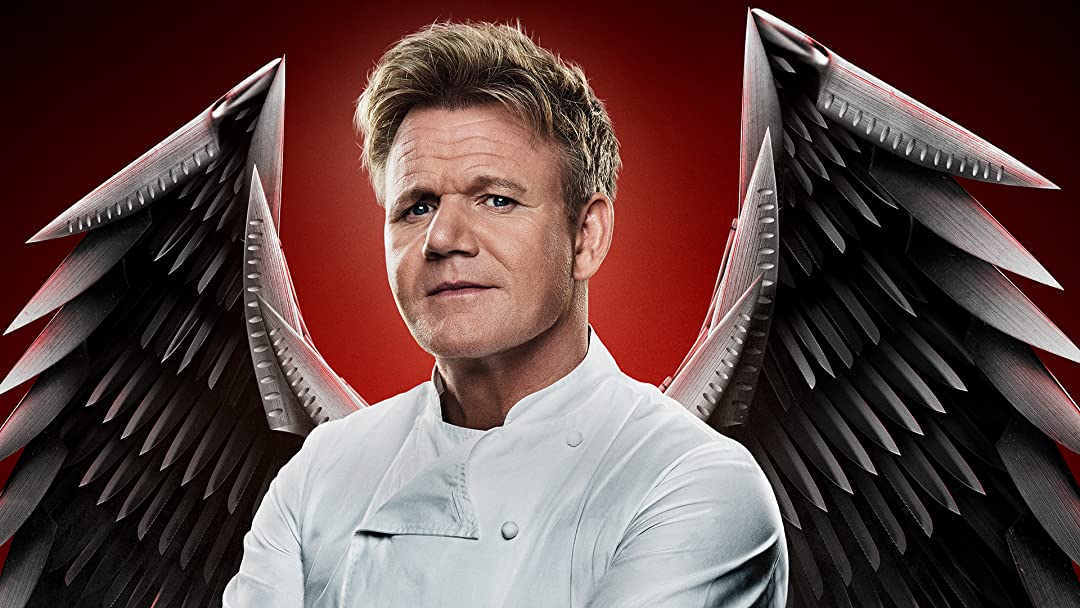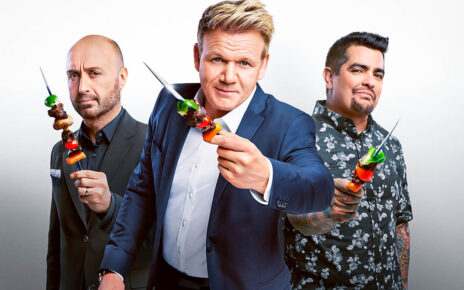Episode description
A Hellish Food Fight
Individual challenge: The teams faced the famed and highly anticipated Blind Taste Test, which was space-themed. Chefs who failed to correctly identify two ingredients caused one of their teammates to get covered in “messy space debris” first was “milky-way” milk. Further incorrect guesses caused dustings of sprinkles followed up by cheese. The teams were evenly matched after the first three rounds of tasting; Ryan got two while Carmen got one, Jason got one while Donya got two, while both Leigh and Dahmere got two each, which meant the score was standing at five-five going into the final round. The dealbreaker came here, as while Johnathan got two, Sammi surprisingly scored zero leaving the final score at seven-five, and gave the blue team their seventh challenge win of the season.
Reward/punishment: The blue team was granted access to a four thousand dollar shopping spree at the Hell’s Kitchen supply store, while the red team was punished with cleaning up the mess caused by the challenge. Many of the contestants of the red team envied the blue team because they had won, and it started to cause arguments among the red team. The blue team watched from the kitchen store as the red team started to turn on each other. This made the blue team members even more happy about their victory.
Service: Hell’s Kitchen was closed for a private charity service. The People Concern charity was represented by actor Greg Germann and was served by the blue kitchen. The Teen Cancer America charity was represented by Rosanna Arquette and was served by the red kitchen. For the full-course charity dinner, each chef was assigned to a course, and was tasked with leading their team and coordinating with the leading chef in the opposing kitchen to deliver their courses simultaneously to both dining rooms. While Sammi, Leigh, Dahmere, and Ryan were particularly notable for their strong leadership abilities, others including Jason and Donya struggled to manage and communicate with their teams effectively. This resulted in quality issues with their courses and the need to re-fire dishes. Both teams lost the service, as Ramsay felt overall leadership on both teams was lacking.
Elimination: The red team nominated Donya and the blue team nominated Jason. Ramsay eliminated Donya, feeling she lacked the necessary leadership skills. Ramsay then told Jason he had not given up on him, but made it clear that he was getting “awfully close” to getting eliminated because this was his fifth time up for elimination, and sent him back in line.
Ramsay’s comment: “Donya had the drive, voice, and was a great cook. But I’m not looking for a great cook. I need a great chef.”
Hell’s Kitchen Season 21
Hell’s Kitchen Season 22
Episode 01 | Episode 02 | Episode 03 | Episode 04 | Episode 05 | Episode 06 | Episode 07 | Episode 08 | Episode 09 | Episode 10 | Episode 11 | Episode 12 | Episode 13 | Episode 14 | Episode 15 | Episode 16
Hell’s Kitchen US Show Summary
The U.S. version of Hell’s Kitchen follows the format of the UK version though the show is recorded and not performed live, nor is there audience participation in the elimination of chefs. Each season brings twelve to twenty aspiring chefs to Hell’s Kitchen, a modified warehouse in Los Angeles that includes the restaurant, dual kitchen facilities, and a dormitory where the chefs reside while on the show. Gordon Ramsay breaks the chefs into two teams most often based on gender, with women on the red team, and men on the blue, and are given a chef’s jacket with labels of that color. The chefs compete in these teams, barring any reassignments by Ramsay, until only five or six chefs are left, which they are brought into a single common team wearing black-labeled jackets, though they now compete individually to be one of the final two. Each episode typically includes one challenge and one dinner service, following which a chef is eliminated from the game.
In challenges, the teams or individual chefs are tasked with a cooking challenge by Ramsay. The type of challenges are varied, ranging from ingredient preparation, meal preparation, taste tests, and other challenges. The first challenge of each season is a signature dish cookoff, giving the chefs the opportunity to show Ramsay their cooking. Each season typically includes one or more challenges that allows teams to construct several dishes either for a banquet to be held the next dinner service or as part of designing their own menus. Other challenges typically include a “taste it, make it” task where chefs must try to recreate a dish Ramsay has prepared by taste only, and a taste-test challenge where chefs identify ingredients without sight or sound. The winner of the challenge is either determined by a scoring system set for that challenge, or based on Ramsay’s and guest judges’ opinions. The winning team or chef is typically rewarded with an activity away from Hell’s Kitchen and other potential prizes, while the losing team or chefs are forced to do a menial task, such as cleaning the kitchens, preparing a specific ingredient for the dinner’s meal, or having to prepare the food for both kitchens.
For dinner services, the chefs are expected to work their station (such as meat, fish, or garnish) on the kitchen line to prepare food in coordination with their teammates and to Ramsay’s high standards for quality and presentation during a dinner service for about 100 guests (volunteers for the show), with each diner expecting to receive an appetizer, an entree, and a dessert. The chefs are given menus and recipe books by Ramsay to study and memorize, which include some of Ramsay’s more difficult plates including risotto and Beef Wellington, and are given a few hours before each service to prep their ingredients. They are also given silverware sets that they get to keep, regardless of their progress. Ramsay demands that all orders for one course for a table go out together, and will send back entire orders if one item is improperly prepared, such as being over- or undercooked or not seasoned correctly. While the chefs are in two teams, Ramsay is assisted by two of his trusted sous-chefs, each monitoring one of the kitchens who will also demand the same standards. The sous-chefs shift to helping to fill available positions once the chefs are on a single black team. One such service in this time period allows each chef to run the pass as part of a quality-control test (i.e. spotting mistakes that are sent up by either Ramsay or one of his sous-chefs).
Ramsay desires to complete every dinner service, but poor kitchen performance by one or both teams will cause him to close one or both sides of the kitchen early, and send the team(s) back to the dorms. Once the dinner service is complete, Ramsay determines which team (if not both) is the losing team and informs them to come up with chefs to be nominated for elimination. This may be a task assigned to the “best of the worst” on the team, or may be a group consensus. Ramsay regroups the teams and hears out the nominations from the losing team(s). After giving these nominees the chance to defend themselves, Ramsay selects one to hand over their jacket and “leave Hell’s Kitchen”, later symbolically placing that jacket on an empty sharp hook below a picture of that chef, in a row in his office; the hook pokes a hole in the jacket and ignites that chef’s picture signaling their departure. Ramsay is free to ignore these elimination rules if he sees fit. He has frequently eliminated chefs during the middle of the service if their performance is abysmal, or may override the provided nominations with his own selection. If an eliminated chef has performed exceptionally well, he may allow that chef to keep their jacket as a token of their success up to that point, if he sees fit. At the end of each episode, as he is seen heading back to his office to hang up the eliminated chef’s jacket, there is a voice-over of him explaining his reasons for eliminating that chef. Often chefs will be taken out of the competition for medical reasons or they may leave on their own free will; though the latter is not encouraged, their wishes are ultimately honored.
Once two chefs remain, they are each given the opportunity to develop their own menu and lead a brigade of former competitors through a full dinner service on their own. In some seasons, this has included the opportunity to decorate half of the Hell’s Kitchen restaurant to their liking. Ramsay will assure that all menu items meet his standards for high cuisine, and will oversee the service to make sure the high quality standards he expects are retained but otherwise does not get involved, allowing the two remaining chefs to demonstrate their ability to run the line to him. Ramsay will use his observations, those from the diners, and other sources to make a decision on who is the winning chef. This process is announced by having the two chefs stand at two different doors from his office, and telling them to turn the door handle and open it; only the door of the winning chef is unlocked. The winning chef receives numerous prizes including the opportunity to work as the head chef or executive chef at a restaurant of Ramsay’s choosing, as well as a cash prize.
[ajax_load_more post_type=”post” posts_per_page=”10″ post_format=”standard” orderby=”modified” placeholder=”true”]



